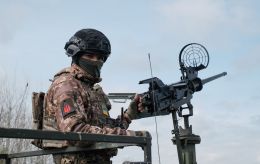Air raids on MiGs, Shaheds and Patriot: Main points from Air Force Command's interview
 Yurii Ihnat, spokesperson for the Air Force Command of the Ukrainian Armed Forces (photo: suspilne media)
Yurii Ihnat, spokesperson for the Air Force Command of the Ukrainian Armed Forces (photo: suspilne media)
In an interview with RBC-Ukraine, the spokesperson of the Air Force Command of the Armed Forces of Ukraine, Yurii Ihnat, talked about the alerts due to the MiG-31K, changes in the tactics of Russian attacks, challenges in the work of Ukrainian air defense, training of Ukrainian pilots on the F-16, and the promised third Patriot battery from Germany.
RBC-Ukraine provides his main statements from the exclusive interview below.
About the latest mass attack of Shaheds on Kyiv
On the night of November 24-25, Russians launched a record number of Shahed-136 combat drones at Kyiv—over 66.
According to Ihnat, these drones approached the capital from two directions—from the Kursk region and Primorsko-Akhtarsk. Attempts were made to destroy them along the way. Up to a dozen drones were destroyed, including in the responsibility zones of the air commands South and East. The air defense in the approaches to the capital and in the capital itself showed 100% effectiveness. According to Ihnat, there were no direct hits.
He also clarified that Shaheds of black color were recorded for the first time during this attack.
"There is no confirmation that there were many such Shaheds, but there is already such a case. According to my information, there was only one such Shahed at the time, which may have been experimentally released to see how our air defense would react to it. But it was also destroyed, as were the ones that flew in the following days - it is already clear that the occupiers began to paint them with spray paint,'" explained the spokesperson for the Air Force Command.
About the importance of mobile fire groups' work
He added that the commander of the Air Force, Lieutenant General Mykola Oleshchuk, after this attack, praised the work of mobile groups because about 40% of the downing that night fell on them.
Their work is important for us because they allow us to save guided anti-aircraft missiles, which are very valuable to us. But to shoot down the rest of the Shaheds that night, powerful anti-aircraft missile systems had to be used.
"The enemy is also well aware of this, so the Russians also have a goal of exhaustion. Therefore, it is necessary to increase the number of means that will be rational for shooting down UAVs. Today, the Gepard is the best in this regard in terms of cost-effectiveness. But it also has a limited range - 4.5 kilometers to shoot down with ground-based projectiles. Therefore, we need more of them - both Gepards and their analogs," explained the spokesperson for the Air Force Command.
About possible repeat Attacks by Russians on energy infrastructure
When asked why Russians have not yet started shelling our energy infrastructure, as Ukraine was on the verge of a blackout during the same period last year, Ihnat responded: Russians will act according to their strategic plan. Their main plan is to destroy Ukraine.
"following their strategic plan. Their main idea is to destroy Ukraine. And believe me, they will want to do us as much damage as possible. Nothing has changed in their policy. If they haven't started such strikes yet, they can do it any other day. But they don't have as many means as they did last year," said Ihnat.
According to him, Moscow now has fewer missiles than it did in September last year before the massive strikes on Ukrainian energy. However, Shaheds are in a different situation—they can both produce and receive more drones from Iran. Therefore, the Air Force believes that Russia, in its attacks, makes and will emphasize strikes with combat UAVs.
"They are not just amassing missiles, they are rebuilding their strategic stockpile. After all, most of the missiles we are talking about are also carriers of tactical nuclear weapons. They need this critical stockpile to threaten NATO countries and other enemies," added Ihnat.
What will happen with the long alarms due to Russian MiG-31K flights
The Air Force will continue to inform about the threat from MiGs and provide this information to the operational duty officer of the State Emergency Service in Kyiv, who is responsible for launching the warning system. At the same time, Ihnat says the country's leadership has instructed relevant ministries and agencies to develop a solution for responding to MiG-31K flights.
"I cannot say what this decision will be. We will continue to inform about the threat," explained Ihnat.
He clarified that Western partners from NATO countries are trying to inform Ukraine as quickly and fully as possible about MiG-31K overflights. In addition, our intelligence also tries to obtain data on the actual threat from the MiG.
"But we don't always have information on whether it's flying with or without a missile, whether it's just a flight, a combat flight, or just a training flight. If there is accurate information that the MiG-31K does not pose a threat, then, of course, no alarm will be raised," explained the spokesperson for the Air Force.
According to him, Russia has three main airfields from which these MiGs take off— Savasleika, Mozdok, and Akhtubinsk.
About the challenges of Ukrainian air defense, the third Patriot battery, and F-16
The problems are not so much in the operation of the air defense system itself but in the quantity of assets needed to cover the entire Ukraine. Of course, we lack the amount of assets. Moreover, there are specific risks in the frontline regions because our air defense assets are a potential target for enemy artillery, MLRS, UAVs, etc.
"Our people are currently undergoing training on Patriot in Germany. Germany has announced that it will provide us with a third system. However, the Air Force does not announce when this will happen or if it has already happened so as not to give the enemy too much information," explained Ihnat.
He reminded us that our pilots are undergoing training on F-16 fighters, which are also intended to strengthen our air defense. Currently, they have transitioned to flying with instructors. This happens in Denmark, the United States, and the United Kingdom.
"We should not be tied to any specifics, promises, or prospects; our goal is to completely renew the fleet of Soviet aircraft: airplanes, helicopters, and UAVs. We have an ultimate goal of about 150 combat aircraft. Plus, of course, training and combat aircraft," said Ihnat.
Read the full interview with the spokesperson for the Air Force, Yurii Ihnat, in the material by RBC-Ukraine.

